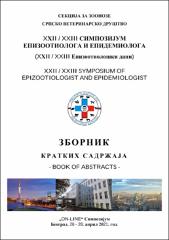Racionalna upotreba antibiotika u veterinarskoj medicini prema regulativi (EU) 2019/6

View/
Date
2021-04-26Author
Todorović, Dalibor
Prunić, Bojana
Pajić, Marko
Velhner, Maja
Tomić, Zdravko
Metadata
Show full item recordAbstract
Regulation (EU) 2019/6 on Veterinary Medicinal Products provides a wide range of concrete measures for the rational use of antibiotics in veterinary medicine. The first EU expert group "ad hoc" for advice on antimicrobial resistance (AMEG) in December 2019, made a classification of antibiotics into 4 categories. Category A "avoid antibiotics" (carbapenem, monobactam, glycopeptide, glycocycline, oxazolidine, ketolide, lipopeptide, streptogramin and rifamycin) are authorized only for use in the human population. Category B "restricted-use antibiotics" (third and fourth generation cephalosporins, polymyxins, quinolones and fluoroquinolones) are used only when no lower-grade antibiotics exist. Category C "caution antibiotics" (first and second generation cephalosporins, macrolides, aminoglycosides, and lincosamides) used solely on the basis of a preliminary examination of their susceptibilities. Category D "prudence antibiotics" (aminopenicillins with beta-lactamase inhibitors, penicillins, streptomycin, tetracyclines, nitrofurans and nitroimidazoles) have the lowest public health risk. If there are no specific recommendations for avoiding the use of Category D antibiotics, there is a recommendation for their use. Unnecessary use and unnecessarily long treatment periods should be avoided, and group treatment should be restricted to situations where individual treatment is not feasible. Regulation (EU) 2019/6 recommends a list of antibiotic (107-b) which could be used only in exceptional circumstances when no other options for therapy of ill animals exists and bacteria is susceptible to certain (target) antibiotic.
